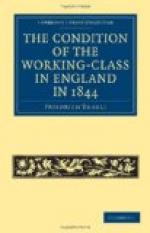On the occasion of an inquest held Nov. 14th, 1843, by Mr. Carter, coroner for Surrey, upon the body of Ann Galway, aged 45 years, the newspapers related the following particulars concerning the deceased: She had lived at No. 3 White Lion Court, Bermondsey Street, London, with her husband and a nineteen-year-old son in a little room, in which neither a bedstead nor any other furniture was to be seen. She lay dead beside her son upon a heap of feathers which were scattered over her almost naked body, there being neither sheet nor coverlet. The feathers stuck so fast over the whole body that the physician could not examine the corpse until it was cleansed, and then found it starved and scarred from the bites of vermin. Part of the floor of the room was torn up, and the hole used by the family as a privy.
On Monday, Jan. 15th, 1844, two boys were brought before the police magistrate because, being in a starving condition, they had stolen and immediately devoured a half-cooked calf’s foot from a shop. The magistrate felt called upon to investigate the case further, and received the following details from the policeman: The mother of the two boys was the widow of an ex-soldier, afterwards policeman, and had had a very hard time since the death of her husband, to provide for her nine children. She lived at No. 2 Pool’s Place, Quaker Court, Spitalfields, in the utmost poverty. When the policeman came to her, he found her with six of her children literally huddled together in a little back room, with no furniture but two old rush-bottomed chairs with the seats gone, a small table with two legs broken, a broken cup, and a small dish. On the hearth was scarcely a spark of fire, and in one corner lay as many old rags as would fill a woman’s apron, which served the whole family as a bed. For bed clothing they had only their scanty day clothing. The poor woman told him that she had been forced to sell her bedstead the year before to buy food. Her bedding she had pawned with the victualler for food. In short, everything had gone for food. The magistrate ordered the woman a considerable provision from the poor-box.
In February, 1844, Theresa Bishop, a widow 60 years old, was recommended, with her sick daughter, aged 26, to the compassion of the police magistrate in Marlborough Street. She lived at No. 5 Brown Street, Grosvenor Square, in a small back room no larger than a closet, in which there was not one single piece of furniture. In one corner lay some rags upon which both slept; a chest served as table and chair. The mother earned a little by charring. The owner of the house said that they had lived in this way since May, 1843, had gradually sold or pawned everything that they had, and had still never paid any rent. The magistrate assigned them 1 pound from the poor-box.
I am far from asserting that all London working-people live in such want as the foregoing three families. I know very well that ten are somewhat better off, where one is so totally trodden under foot by society; but I assert that thousands of industrious and worthy people—far worthier and more to be respected than all the rich of London—do find themselves in a condition unworthy of human beings; and that every proletarian, everyone, without exception, is exposed to a similar fate without any fault of his own and in spite of every possible effort.




